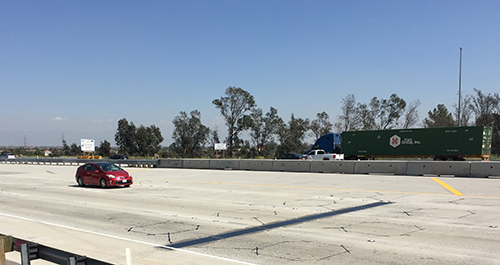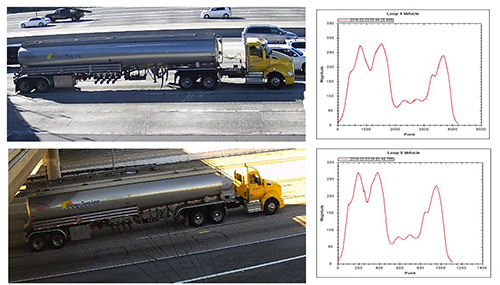Measuring Traffic Performance through Innovative Low-Cost Solutions
Approximately 6 million commercial motor vehicle (CMV) drivers travel along our nation’s roadways on an annual basis. Capturing CMV travel data is an essential component of improving and maintaining roadway safety.
Capturing data such as a vehicle’s presence, speeds, and travel patterns allows for a better understanding of CMV behavior and related implications, such as the type of freight CMVs are carrying and where they’re going.
CMV travel data is collected in a variety of ways: through static scales at weigh stations along highways, physical inspections, and weigh-in-motion (WIM) technologies.

One of CLR Analytics’ weigh-in-motion test study sites in Southern California. This dual ILS loop WIM site is one of 17 test sites CLR Analytics has through its partnership with the California Department of Transportation.
WIM devices collect travel data as a CMV drives over measurement sensors placed on highways, eliminating the need for the driver to stop for an inspection or pull over at a weigh station. Among the CMV data collection technologies, WIM devices are the most precise and efficient, but are costly to maintain and operate.
An Innovative Solution to Travel Data Collection
With funding from the Federal Highway Administration (FHWA) through the U.S. Department of Transportation’s (U.S. DOT) Small Business Innovation Research (SBIR) program, CLR Analytics, Inc. is addressing the limitations of current WIM technologies with a newly developed Inductive Loop Signature (ILS) tracking system that accurately measures a vehicle's travel time and purpose.
The ILS tracking system provides a low-cost and low-maintenance solution to existing WIM devices. As part of this innovative solution, ILS tracking sensors are added onto pre-existing WIM devices to capture a more complete set of detailed vehicle information that can be used to identify out-of-calibration stations, as well as estimate truck activities and load distributions.
At a cost of $700 per sensor, the ILS tracking system provides a practical solution to identifying highway traffic and predicting traffic patterns.

The Inductive Loop Signature technology includes a series of wires across the pavement’s surface at different points on the highway that capture the type of vehicle that crosses over them. The wavelength data can capture the same tanker truck crossing over a series of wires looped on the pavement surfaces at different points on the highway.
FHWA selected CLR Analytics, Inc. for a Phase I SBIR award in 2012 and subsequent Phase II award in 2014 to research and develop cost-effective vehicle data collection solutions and enhanced vehicle identification algorithms to better track CMV travel data. Through these SBIR awards, CLR Analytics, Inc. received approximately $950,000 from FHWA for this research.
Implementing ILS Technology in the Field
To test the efficacy of this new tool, CLR Analytics, Inc. partnered with the California Department of Transportation (Caltrans) to deploy the ILS system at 17 freeway sites in California and one arterial site in Minnesota.
Caltrans found that data collected from ILS sensors provided more accurate and comprehensive traffic data by identifying an increase or decrease of vehicle emissions passing over the sensors, based on the amount of traffic on the road. This traffic monitoring method provides a more cost-effective rate than current technologies allow.
Following the successful development and demonstration with Caltrans, CLR Analytics, Inc. has moved to further commercialize the ILS technology with numerous state transportation departments.
In addition to collecting CMV travel data, CLR Analytics, Inc. foresees the following potential future applications of ILS technology:
- Using ILS data to estimate CMV emissions
- Identifying and monitoring recreational vehicles at state parks
- Providing solutions for all-electronic toll collecting
- Determining travel time and travel time reliability
For more information on how ILS technology works, watch a video of ILS in action.
About the SBIR Program
Administered by Volpe, the U.S. DOT SBIR program is a highly competitive, awards-based program that encourages domestic small businesses to engage in research or development, addressing high-priority transportation needs.

